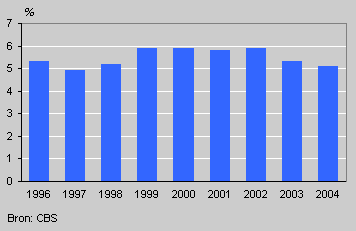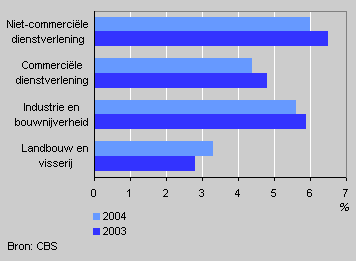Sick leave rate down in first quarter 2004

In the first quarter of 2004 the sick leave rate in the private and public sectors dropped. In the private sector the rate dropped by 0.2 of a percent point compared to one year previously, in the public sector by 0.4 of a percent point.
Downward trend continues
The sick leave rate for the private sector averaged 5.1 percent in the first quarter of 2004. It means that on an average day one in twenty employees reported sick. In the first quarter of 2003 one in nineteen employees reported sick. The sick leave rate was already falling in 2003.
Sick leave in the private sector, 1st quarter

Sick leave up in agriculture
The sick leave rate dropped significantly in the non-commercial sector; from 7.0 percent in the first quarter of 2003 to 6.6 percent in the first quarter of 2004. Health and welfare was mainly accountable. The rate fell in this sector fell from 7.6 to 6.9 percent. In manufacturing industry and the commercial sectors the rate also dropped. In the sector agriculture, on the other hand, absence due to sickness went up from 2.8 percent in the first quarter of 2003 to 3.3 percent in the first quarter of 2004.
Sick leave in the private sector, 1st quarter

Large companies have lower sick rates
Absence due to sickness was much lower in the first quarter of 2004 among employees working for large companies. The sick leave rate in companies employing one hundred persons or more decreased from 6.6 percent in the first quarter of 2003 to 6.1 percent in the first quarter of 2004. In noticeable contrast with small enterprises employing fewer than ten persons where the sick leave rate rose from 2.7 to 3.2 percent over the same period.
Sick leave in the public sector, 1st quarter

Sick leave public sector down for the third year in a row
In the sector central government absence due to sickness dropped from 7.3 percent in the first quarter of 2003 to 6.9 percent in the first quarter of 2004. The rate has dropped for the third consecutive year.
John Kartopawiro